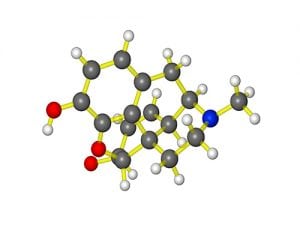
Learn more about Morphine and its uses, side effects, and more.
Morphine is an opiate analgesic that is currently the most powerful painkiller available to the medical profession. It is available as a generic preparation and under a number of brand names such as:
- MS-Contin
- Oramorph
- Roxanol
- Kadian
CONTACT US TODAY
Morphine acts directly on the nervous system by binding to receptors in the brain. It acts very quickly and can be used to treat acute or chronic pain that is moderately severe to severe. The active agent in morphine is opium.
Morphine was first developed in 1804 by a German pharmacist. It is named after the Greek god of sleep, Morpheus. Extended use of morphine commonly produces both physical and psychological dependence.
Uses
Morphine has many legitimate uses, but it is most often the medication of choice for severe, chronic pain. This includes the pain caused by a heart attack and the deep, intractable agony of terminal cancer. It can also offer relief after major surgery and the trauma of an automobile accident or other serious injury.
Morphine can be used for lesser disorders as a cough suppressant and to treat chronic diarrhea, but other medications that do not have the same risk of dependence are usually preferred.
Almost every form of delivery is used for morphine. It is available as a liquid injectable, an oral liquid, a suppository, and as either fast-acting or slow-release capsules and tablets. It is vital to take morphine exactly as it was prescribed. Extended release forms should not be crushed or dissolved, as this delivers the entire dose at once and may be fatal.
Morphine can be used in some form in people of any age, including very young children. It is not suitable for people with breathing problems, head injuries, a history of substance abuse, or various organ diseases.
Side Effects

Tolerance and Dependence
Morphine is extremely addictive with habitual use. Both medically prescribed and recreational use produce physical and psychological dependence. Patients who need to stay on therapeutic doses for a long time due to the chronic nature of their pain typically develop tolerance and need to switch to higher-dose preparations.
Because morphine is used to alleviate severe pain, people who use it are at particular risk for overdose. Despite warnings, they may seek relief by taking the drug in higher or more frequent doses. The signs of overdose include shallow, irregular breathing, loss of consciousness, clammy skin, constricted pupils, blurred vision, and vomiting. Overdose requires immediate medical care.
Withdrawal Symptoms
Stopping the use of morphine, either suddenly or by tapering off too quickly, produces severe, unpleasant symptoms. These include vomiting, sweating and chills, watering eyes, and running nose, headaches, bone pain, and increased heart rate. It also causes psychological symptoms such as irritability, insomnia, and extreme cravings for the drug.


